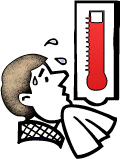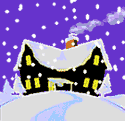

It is all about the
tilt of the Earth's axis. Many people believe that the temperature
changes because the Earth is closer to the sun in summer and farther
from the sun in winter. In fact, the Earth is farthest from the
sun in July and is closest to the sun in January! The Earth's
movement around the sun causes the seasons, but it does not affect
the temperatures during the seasons.
During the summer,
the sun's rays hit the Earth at a steep angle. The light does
not spread out as much, thus increasing the amount of energy hitting
any given spot. Also, the long daylight hours allow the Earth
plenty of time to reach warm temperatures.
During the winter,
the sun's rays hit the Earth at a shallow angle. These rays are
more spread out, which minimizes the amount of energy that hits
any given spot. Also, the long nights and short days prevent
the Earth from warming up. Thus, we have winter!
 Related
Web Sites Related
Web Sites |
- Earth:
What causes the Seasons? This Web site from NASA KIDS
and the Marshall Space Flight Center contains an animated
video describing the Earth’s Seasons.
- What
causes the Seasons-
From the Windows
to the Universe Web site, "What causes the seasons"
is explained using different learning levels (beginner,
intermediate, and advanced). There are hyperlinks (bold
underlined words) within the text that direct you to other
related pages on the topic of seasons.
-
“Eyes
on the Sky, Feet on the Ground” - This Web site
is part of The Smithsonian Astrophysical Observatory's
Using Science and the Internet as Everyday Classroom tools.
It contains a collection of children's online astronomy
activities. You can read chapters on the Earth's rotation
or orbit by going to the Table of Contents link at the
bottom of the page.
- Earth's
Seasons Equinoxes, Solstices, Perihelion, and Aphelion 1992-2020
- The United States Naval Observatory Website provides a
list of the starting dates of the seasons through 2020.
|
 Further
Reading Further
Reading |
- Asimov,
Isaac. Ask Asimov’s guide to earth and space. New
York, Random House. 1991. 285 p. (Questions and Answers).
- Campbell,
Ann-Jeanette. The New York Public Library incredible
Earth: a book of answers for kids. New York, Wiley,
c.1996. 186 p.
- Gutsch,
William A. Jr. 1001 Things everyone should know about
the universe. New York, Doubleday,1998. 353 p.
- Thompson,
Luke. Earth. New York, PowerKids Press, 2001. 24
p. (Juvenile).
- Pasachoff,
Jay. Astronomy: from the earth to the universe, 6th edition.
United States, Brooks/ Cole- Thompson Learning, c. 2002.
1v. various pagings.
|
 For
more print resources... For
more print resources...
Search on "season,"
"equinox," or "solstice"
in the Library of Congress Online
Catalog.
|
 Summer
Summer
More
hours of sun / daylight
The
sun’s rays come in at a steeper angle, with fewer layers of
atmosphere to filter through.
 Winter
Winter
Fewer hours of sun / daylight
The
sun’s rays come in at a shallow angle with more atmosphere
to filter through.
|


 Summer
Summer Winter
Winter